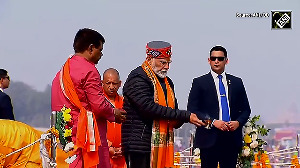If one were to place an order with Welspun for terry towels or bed linen now, the earliest the company can deliver will be some time in 2008, its new facility in Gujarat put up at a cost of Rs 600 crore (rs 6 billion) notwithstanding.
"All our production is booked till December 2007," says a beaming Bal Krishan Goenka, the vice-chairman and managing director of Welspun. Goenka has to execute orders placed by top brands like Tommy Hilfiger, Nautika, Wal-Mart and JC Penney, and all his mills are running overtime.
Gokaldas Exports Executive Director Rajan Hinduja is targeting a 20 per cent per annum growth for the next two years. "We are confident of registering a turnover of more than Rs 850 crore by the end of 2005-06 and our target will be to grow by 20 per cent in the subsequent years," he says. OP Lohia, Indo Rama Synthetics' managing director expects his business to grow by over 10 per cent in 2006.
Textile barons such as Goenka and Hinduja look forward to a bountiful 2006. The latest estimates suggest that Indian textile exports will be close to $15 billion in 2005, up almost 20 per cent over 2004. The projections for next year are even better: exports of $18.5 billion, signalling growth of about 25 per cent.
The US, which is India's largest market accounting for 27 per cent of textile exports, is likely to maintain its momentum in 2006 - Indian exports to the US grew almost 25 per cent in January-October 2005.
Growth in the EU, however, is likely to fall from the 17 per cent reported in January-July 2005. Also, the 15-20 per cent price correction seen in the EU in 2005, is likely to spread to the US in 2006.
In 2005, several large retailers including Wal-Mart scaled up their procurement from India. This trend could gather force in the coming year. The industry expects a string of big retailers to come to India with large orders in 2006.
Some of the names doing the rounds are Zara, Mothercare and Armani. Also, there is evidence that the new export orders are better priced than those going to China, on account of the fine craftsmanship in the country.
So much so that some Chinese garment makers are known to be scouting for craftsmen in India who can go and work in their factories!
"Our labour cost is low. With the Technology Upgradation Fund, good firms can get credit at rock bottom rates, and captive power rates are globally competitive," says a large North India-based textile major.
Also, cotton prices are projected to soften further in 2006 as another bumper crop is expected, owing to the induction of genetically-modified cotton seeds. Man-made fibre prices too might drop a little, with the drop in global crude prices.
The big worry remains China. During 2005, Chinese exports grew by as much as 60 per cent, forcing the US to clamp quotas on some product lines. As these quotas will be there till 2008, Indian exporters are planning to cash in on this opportunity.
Over the next two years, the industry is expected to invest around Rs 23,000 crore in new capacity, and refurbishing existing lines. A slew of textile companies are expected to raise money from the market. Private equity funds like Temasek and ICICI Ventures have started taking an exposure to the sector.
But is all this enough? Probably not. According to a study carried out by KSA Technopak, this is just over a third of the Rs 63,000-crore worth of investments required if India is to meet its target of $50 billion textile exports by 2010.






 © 2025
© 2025